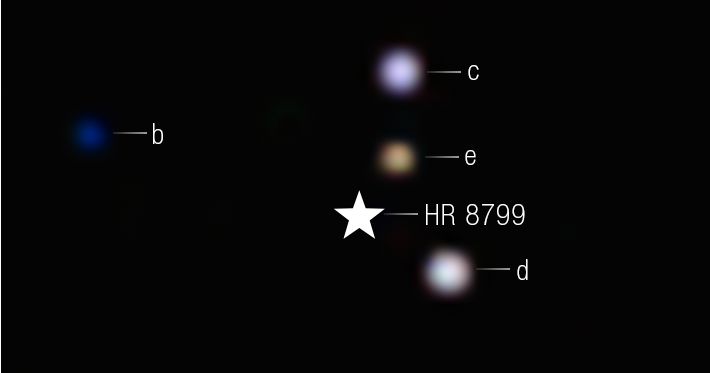The James Webb Space Telescope has directly observed the key chemical of carbon dioxide in planets outside of our solar system for the first time, scientists announced Monday.
The gas giants are not capable of hosting extraterrestrial life, but do offer clues in a lingering mystery about how distant planets form, according to a study in The Astrophysical Journal.
The HR 8799 system, 130 light years from Earth, is only 30 million years old — just a baby compared to our solar system’s 4.6 billion years. A U.S.-led team of researchers used Webb to directly detect carbon dioxide in the atmosphere of all four of the system’s known planets, according to the study.
“Webb’s new images of two iconic systems, HR 8799 and 51 Eridani, and their planets have stunned researchers, and provided additional information into the chemical make-up of the young gas giants,” NASA said in a statement.
NASA
They used Webb’s coronagraph instruments, which block the light from bright stars to get a better view of the planets revolving around them.
“It’s like putting your thumb up in front of the sun when you’re looking up at the sky,” lead study author William Balmer, an astrophysicist at Johns Hopkins University, told AFP.
Normally, the Webb telescope only detects exoplanets by glimpsing them when they cross in front of their host star.
This “transiting method” was how Webb indirectly detected CO2 in the atmosphere of the gas giant WASP-39 in 2022.
But for this latest discovery, “we’re actually seeing the light that is emitted from the planet itself, as opposed to the fingerprint of that light from the host star,” Balmer said.
This is not easy — Balmer compared the process to using a torch to spot fireflies next to a lighthouse.
While these gas giants may not be able to host life, it is possible that they had moons that could, he added.
There are missions currently under way to find out if there could be life in the vast oceans underneath the icy shells of several of Jupiter’s moons.
“Key piece of proof”
Carbon dioxide (CO2) is essential for life on Earth, making it a key target in the search for life elsewhere.
Because CO2 condenses into little ice particles in the deep cold of space, its presence can shed light on planetary formation.
Jupiter and Saturn are believed to have first formed from a “bottom up” process in which a bunch of tiny, icy particles came together into a solid core which then sucked in gas to grow into giants, Balmer said.
So the new discovery is a “key piece of proof” that far-off planets can form in a similar way to those in our celestial backyard, Balmer said.
But how common this is throughout the universe remains unclear.
“Our hope with this kind of research is to understand our own solar system, life, and ourselves in the comparison to other exoplanetary systems, so we can contextualize our existence,” Balmer said. “We want to take pictures of other solar systems and see how they’re similar or different when compared to ours. From there, we can try to get a sense of how weird our solar system really is—or how normal.”
NASA
Astronomers have now discovered nearly 6,000 exoplanets, many of them massive — and none of them known to be habitable.
The “huge leap forward we need to make” is to focus on smaller Earth-sized worlds, Balmer said.
NASA’s Nancy Grace Roman space telescope will use a coronagraph to do that just after its planned launch in 2027.
Last year, the Webb telescope discovered carbon dioxide and hydrogen peroxide on the surface of Charon, Pluto’s largest moon.
Balmer hopes to use Webb to observe more four-planet systems, but added that future funding was now in question.
Last week the Trump administration announced that NASA’s chief scientist has been dismissed, indicating that more cuts were to come for the U.S. space agency.


